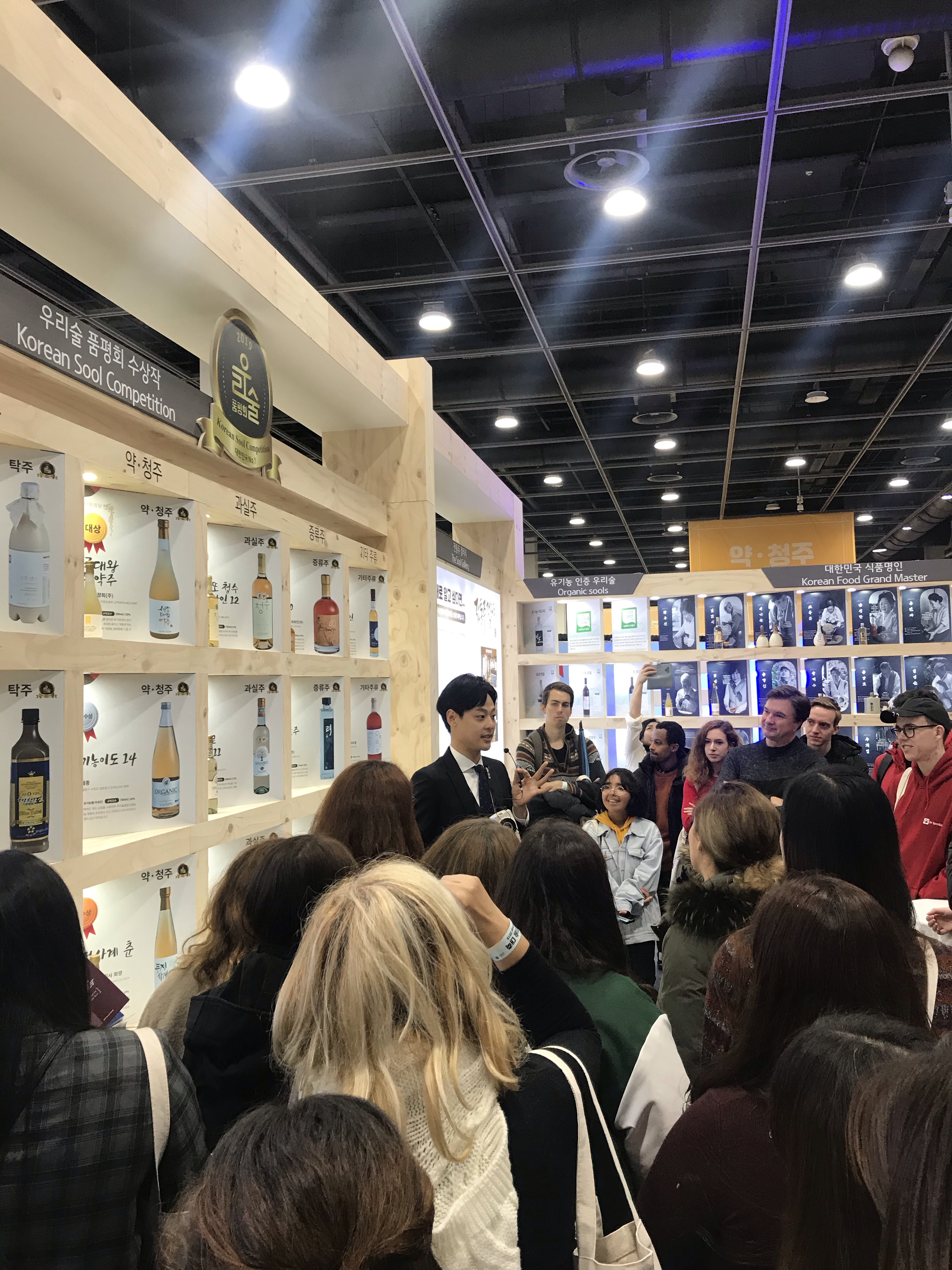Last year, I attended the Korean Sool Grand Festival 2019. You might wonder what is ‘Sool’? Of course, it is a Korean word, which I assume will be a globally well-known term in the future.
The word Sool, in Korean, covers different types of alcohol drinks, including soju, makgeolli, yakju (chongju), and wine. The festival brought various producers of all these drinks in South Korea to be here together.

I attended this festival via registration through Fundaykorea, as they advertised that we would have an opportunity to get hands-on experience in making makgeolli workshop. Makgeolli is my favorite drink in Korea, so I did not hesitate to register for the workshop. However, the participants are overwhelmed, exceeding the size of 30 people they had expected, and the organizer could not manage to conduct the workshop for all in one session. So, some of us were separated to wait for the workshop in the evening round. During the waiting time, the good-looking man in a black suit guided us to different booths of a variety of Korea liquor producers.

Though I was disappointed by not being able to attend the makgeolli workshop, this festival tour was fascinating, and I did not regret participating in this event at all. While walking with us, the man told us the interesting history of each type of Korean drinks by using his little portable speaker. Even though the number of participants was too many for a small speaker, the narrator did his job professionally. The story he told was corresponding with the zone of a specific type of drink. So, while listening to the story, we could sip the hot liquor and taste the differences. I was impressed by this experience.
Moreover, all participants received 10,000 KRW coupons that we could use for buying food and snacks. Most of the Sool booths invited us to taste their drinks in a small portion. Unconsciously, sip after sip, I felt a bit drunk by tasing this samples. Finally, I found the brand that I was so interested in. It is Hangang Brewery (this is not an advertorial content!). They produced a good quality of makgeolli at an affordable price for a student like me. The packaging also caught my eyes. It is like combining traditional Korean drinks with the cool design of the modern age. I even checked their Instagram and found that they posted pictures of the rice field, where their main ingredients originate.


Just like how we see in the Korean dramas, the Koreans do cherish this drinking culture. It is one of their cultural pride. Unlike in my country, here is where most people do not feel embarrassed about drinking in public or even during the usual meals before sunset. They do not fear expressing themselves as frequent alcohol drinkers.
The government is also proud of this culture. This Korean Sool Grand Festival is hosted by the Korean Ministry of Agriculture, Food and Rural Affairs. The reason for hosting this event is also worth praising. They do this to support the local producers, including those who produce unique-taste drinks from the local knowledge and materials within their rural areas. The ministry provided the chances for them to display their products in public and awards the brands in each category annually.
So, we can discover a wide range of alcoholic drinks here. Some contain the flavor and sweetness of milky rice. Some contain a yogurt-like flavor, so sour that my eyes twitched. Some are burning-taste ginger soju that the Korean army drank in their camp during the Korean War (so they say). Just a small sip, my throat felt the burning liquid running into my stomach. Some are expensive and ‘healthy’, by adding famous red ginger in the ingredients.

Alcoholic drinks are not just leisure, but traditional culture. 
Sool tourism. Let Sool lead your journey.


According to the guide, soju, makgeolli, and yakju (chongju) are made from the same ingredients. They are different just in the level of clarity. Makgeolli contains a high level of rice mass lying at the bottom of the bottle, so it looks thicky and has slight viscosity. Yakju is the slightly clearer part of the liquor, on top of the milky part. It tastes very satisfying, still containing a good smell of rice but not being too sweet. Lastly, soju is the distilled version of the brewery, so it looks transparent and has so little sweetness of rice compared to alcohol’s bitterness.
The fun fact that I heard is that the name of Yakju is really related to Yak (the word ‘medicine’ in the Korean language). In some eras, the nobles want to stock their Chongju (the other name of Yakju), while the Choseon king prohibited the food stockpiling, except for medicines. So, they claim that this alcoholic drink was for medical use only, calling it yakju instead. In that way, they were able to stockpile them in their houses. Nowadays, people usually use these names interchangeably.

Though I eventually did not participate in the workshop (because I was then too dizzy), I felt lucky that I got these souvenirs in the canvas bag. The most special one is the soju from Andong, which I was the only one in my group that received it.
Moreover, I accidentally stood on the way that Yuri of Girls’ Generation walked pass, with the herd of journalists trying to reach her. I did not even know that she came.
I wished that one day, my country will be more open-minded to this alcohol-drinking culture. Now, just posting the pictures of them, even if there is no label shown, is risky to violate the law. I do believe that the alcohol producers in my country, whether they are big or small, old or new, have an ability to create their own quality tastes.
We just need the support from the governmental organization and society, just the Koreans do.





